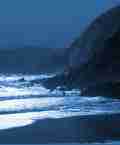 |


|
|||
Falavee - from 'Traveller in the Glens'The following text is excerpted from Traveller in the Glens by Jack McBride, published in a new paperback edition by Appletree Press.
Galbolly’s BooleyGalbolly [the village mentioned on the previous page] is a peaceful law-abiding place these days, but for all that it has in winter a queer, eerie appearance – perhaps an echo of its lawless days, and it is a strange fact that for three months of the year - December, January and February - not a direct ray of sunshine ever shines into its houses or over its fields! It was long the custom in mountainous districts for the people to put in their crops in the lowland fields, then migrate to the mountainy upper-lands, where they stayed during the summer, grazing their cattle and sheep. The Galbolly folk followed this custom for centuries, and today, on the mountains overlooking this ‘Hidden Village’, theremains of the ‘booley’, or clachan of beehive-shaped huts, may clearly be traced.
In Here’s Ireland by Harold Speakman (Robt. McBride & Co. , New York, 1931) a most interesting account of an American’s tour through Ireland with a donkey, the following passage occurs relative to ‘booleys’:
‘Here is the surprising testimony of Sir Wm. Wilde, written in 1835: “There are several villages in Achill, particularly those of Keene and Keele, where the huts of the inhabitants are all circular or oval, and built for the most part of round, water-washed stones, collected from the beach, and arranged without lime or any other cement, exactly as we have reason to believe that the habitations of the ancient Firbolgs were constructed. There we have a picture of the booley system, and the remains on Galbolly Top show that the custom existed there down to fairly recent times.
|
[ Back to top ]
All Material © 1999-2008 Irelandseye.com and contributors
